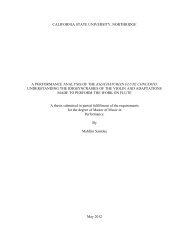Page 1 The California ""- Geographer Annual Publication of the ...
Page 1 The California ""- Geographer Annual Publication of the ...
Page 1 The California ""- Geographer Annual Publication of the ...
Create successful ePaper yourself
Turn your PDF publications into a flip-book with our unique Google optimized e-Paper software.
Although common salt is among <strong>the</strong> less spectacular marine products<br />
<strong>of</strong> commerce, <strong>the</strong>re seems to be no end in <strong>the</strong> demand for this resource.<br />
Solar evaporation, <strong>the</strong> most common process used to obtain salt from <strong>the</strong><br />
sea, is <strong>the</strong> basis for salt trade originating at this port. Salt operations were<br />
conducted in <strong>the</strong> immediate vicinity <strong>of</strong> Laguna Guerrero Negro for <strong>the</strong><br />
last 80 years in a desultory fashion. However, in 1951, after a survey indicated<br />
promise, modern industrial techniques were introduced. By mid-<br />
1963 approximately 21 million dollars had been invested in evaporation,<br />
bulkloading, and administrative facilities at <strong>the</strong> port and Pueblo Guerrero<br />
Negro, a nearby settlement. This investment has been managed by<br />
National Bulk Carriers, New York City, <strong>of</strong> which Exportadora de Sal is a<br />
subsidiary.2<br />
<strong>The</strong> port is reached via a seven-mile channel that is kept open by<br />
dredging. Because <strong>the</strong> channel walls are continually slumping, dredging<br />
is virtually a 24-hour task. Natural protection is given <strong>the</strong> port by <strong>the</strong><br />
barrier island. Pilotage is required, and since Puerto Venustiano Carranza<br />
is a port-<strong>of</strong>-entry, customs and stores inspections are likewise mandatory.<br />
Port captain's duties are discharged informally by <strong>the</strong> salt company manager.<br />
No personnel <strong>of</strong> <strong>the</strong> Armada de 1\!lexicana are stationed at <strong>the</strong> port,<br />
consequently <strong>the</strong> chief federal <strong>of</strong>ficer and authorized port captain is an<br />
Army <strong>of</strong>ficer commanding a garrison <strong>of</strong> 22 troops at Guerrero Negro.<br />
Controlling depth <strong>of</strong> <strong>the</strong> entrance channel is 28 feet. <strong>The</strong> channel<br />
is buoyed for 6.3 miles <strong>of</strong> its length and is marked by ranges. Two square<br />
miles <strong>of</strong> anchorage lie within a three-mile arc <strong>of</strong> <strong>the</strong> headlands. In an<br />
emergency at least five times that area could be obtained for fair wea<strong>the</strong>r<br />
mooring.<br />
To <strong>the</strong> casual eye at Rood tide, all parts <strong>of</strong> <strong>the</strong> lagoon appear open<br />
to navigation. However, extensive shallow Rats appear on <strong>the</strong> falling tide.<br />
Access to <strong>the</strong> upper reaches can only be obtained via lateral channels<br />
formed into a tortuous dendritic pattern. <strong>The</strong> lower laterals are 150 feet<br />
wide and remain well-defined for as much as eight miles from <strong>the</strong> barrier<br />
entrance before <strong>the</strong>y grade into shallow water. However, <strong>the</strong> sou<strong>the</strong>rn<br />
channel can be ascended only three miles with a vessel drawing six feet,<br />
while <strong>the</strong> nor<strong>the</strong>rn channel is open for scarcely double that distance.<br />
Configurations <strong>of</strong> <strong>the</strong> channels and <strong>the</strong> adjoining shelves are such<br />
that tides Rood <strong>the</strong> lagoon complex with remarkable celerity. <strong>The</strong> tide<br />
rises across <strong>the</strong> tidal Rats almost faster than a man can walk; consequently,<br />
vast areas become inundated within a few minutes. By reverse token, ebbs<br />
quickly expose <strong>the</strong> Rats. Shallow pools appear in pr<strong>of</strong>usion across <strong>the</strong> Rats<br />
after low water, but <strong>the</strong>se are never more than a few yards in diameter<br />
and only a fraction <strong>of</strong> a foot deep. After a short time <strong>the</strong>se pools disappear,<br />
probably by vertical drainage, and <strong>the</strong> bare tidal Rats seem completely<br />
free <strong>of</strong> any life.<br />
Notwithstanding <strong>the</strong> formidable appearance <strong>of</strong> <strong>the</strong> tidal race, currents<br />
are not greater than 2.3 knots. Phleger3 made a similar observation in<br />
2 Cutting, P. J., Director General, Exportadora de Sal, S. A., personal communication,<br />
1963.<br />
3 Phleger, Fred B., and Gifford C. Ewing, "Sedimentology and Oceanography <strong>of</strong><br />
Coastal Lagoons in Baja <strong>California</strong>, Mexico," Bulletin <strong>of</strong> <strong>the</strong> Geological Society <strong>of</strong><br />
America, Vol. 73, 1962, 145-182.<br />
31













